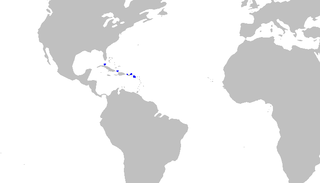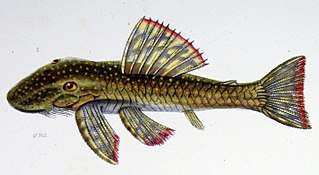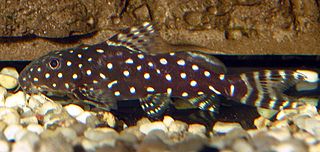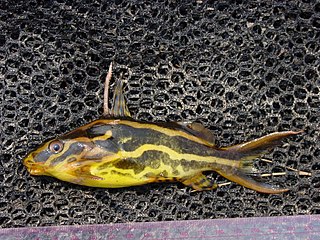
The smoothtooth blacktip shark is a species of requiem shark in the family Carcharhinidae. It is known only from the type specimen caught from the Gulf of Aden, off eastern Yemen, and a handful of additional specimens caught from the Persian Gulf, off Kuwait. Reaching 1.3 m (4.3 ft) in length, this species has a stocky greenish-colored body, a short snout, and black-tipped fins. It can be distinguished from similar species by its teeth, which are narrow, erect, and smooth-edged.

The dwarf sawtail catshark is a little-known species of catshark, belonging to the family Scyliorhinidae, found exclusively in the deep waters off Luzon in the Philippines. Unlike other members of its genus, this slender, diminutive shark has a short, rounded snout and very short furrows at the corners of its jaws. It has indistinct darker saddles beneath each dorsal fin and two dark bands on the caudal fin, as well as a prominent crest of enlarged dermal denticles along the upper caudal fin margin.

Springer's sawtail catshark is a species of catshark, belonging to the family Scyliorhinidae, found in waters 457–699 m (1,499–2,293 ft) deep off the islands of the Antilles, from Cuba to the Leewards. A small, slim-bodied species reaching a length of 48 cm (19 in), the Springer's sawtail catshark can be identified by its color pattern of horizontal dark stripes in front of the first dorsal fin, and dark dorsal saddles behind. It is additionally characterized by the presence of saw-toothed crests, made of enlarged dermal denticles along both the dorsal and the ventral edges of the caudal fin. The Springer's sawtail catshark is oviparous.

The dwarf lanternshark is a species of dogfish shark in the family Etmopteridae and is the smallest shark in the world, reaching a maximum known length of 20 cm (8 in). It is known to be present only on the upper continental slopes off Colombia and Venezuela, at a depth of 283–439 m (928–1,440 ft). This species can be identified by its small size at maturity, long flattened head, and pattern of black ventral markings and a mid-dorsal line. Like other members of its genus, it is capable of producing light from a distinctive array of photophores. Reproduction is aplacental viviparous, with females gestating two or three young at a time. The dwarf lanternshark is not significant to commercial fisheries, but could be threatened by mortality from bycatch; the degree of impact from human activities on its population is unknown.

Lasiancistrus is a genus of suckermouth armored catfishes. They are native to South America and Panama.
Pseudolithoxus is a genus of suckermouth armored catfishes with five described species from the basins of the Orinoco, Casiquiare and upper Rio Negro in Venezuela. Additionally, a possibly undescribed species is known from the Trombetas and Nhamundá rivers in Brazil.
The narrowbar swellshark is a rare species of catshark, and part of the family Scyliorhinidae, known only from two specimens collected near Flinders Reef off northeastern Australia. This species reaches at least 44.5 cm (17.5 in) in length, and has a stocky body with a short, broad head. It can be readily identified by its zebra-like dorsal color pattern of transverse brown bars on a yellowish background. Like other swellsharks, it can inflate its body as a defensive measure.
The speckled swellshark is a little-known species of catshark, and part of the family Scyliorhinidae, endemic to the waters off northwestern Australia. It occurs on the outer continental shelf and upper continental slope, at a depth of 150–455 m (492–1,493 ft). This species grows to 69 cm (27 in) long and has a stocky body and a short, broad, flattened head. As its common name suggests, its color pattern consists of many dark spots and white-spotted dark saddles and blotches on a light gray background. The juveniles are yellow with dark spots and lines, and a distinctive eyespot-like mark behind each eye. Like other swellsharks, this species can inflate itself as a defensive measure.

Synodontis angelicus is a species of upside-down catfish commonly named polkadot squeaker, black clown catfish, whitespotted squeaker, pearl squeaker, or angel squeaker. This species is native to the Congo Basin in the Democratic Republic of the Congo and the Republic of the Congo. It was originally described in 1891 by Belgian ichthyologist Louise Schilthuis after its discovery in the Malebo Pool of the Congo River. The specific name "angelicus" means heavenly or divine, since juveniles of this species are remarkable for their bright coloring.

Synodontis flavitaeniatus, known as the orangestriped squeaker, the chocolatestriped squeaker, the yellowstriped squeaker, and the pyjama Syno, is a species of upside-down catfish native to the Democratic Republic of the Congo and the Republic of the Congo where it is found in the lower and central Congo Basin. It was first described by Belgian-British zoologist George Albert Boulenger in 1919. The holotype was collected from the Ruki River at Eala, in the Democratic Republic of the Congo. The meaning of the specific name "flavitaeniatus" is "yellow stripes".

Synodontis greshoffi is a species of upside-down catfish native to the Congo Basin of Cameroon, the Democratic Republic of the Congo and the Republic of the Congo. It was first collected by M.A. Greshoff in Pool Malebo on the upper Congo River, and the species was named for him by the author of the first paper written about the species, Belgian ichthyologist Louise Schilthuis, in 1891.
The painted swellshark is a little-known species of catshark, belonging to the family Scyliorhinidae, found in eastern Indonesia. This species reaches a maximum known length of 72 cm (28 in), and has a thick body with a short, broad and flattened head. It is dark gray with a variegated pattern of irregular darker and lighter blotches above, and lighter below with gray blotches and speckling on the snout. Like other swellsharks, it can inflate itself as a defensive measure.
The flagtail swellshark is a little-known species of catshark, belonging to the family Scyliorhinidae, found at a depth of 480–700 m (1,570–2,300 ft) off northeastern Queensland, and possibly also nearby islands. This stout-bodied shark has a short, broad, and flattened head with a capacious mouth. Adults have a variegated brown coloration with 9–10 darker dorsal saddles and "V"-shaped blotch at the tip of the upper caudal fin lobe. Juveniles are yellow with narrow brown bars instead of saddles, and a distinctive marking between the spiracles shaped like two loops connected by a line. Like other swellsharks, this species can inflate its body when threatened.

Cirrhibarbis capensis, the barbelled klipfish, is a species of clinid found in subtropical waters of the Atlantic Ocean around South Africa. This species can reach a maximum length of 36 centimetres (14 in) TL. This species preys primarily on benthic crustaceans, mostly amphipods and isopods. It is currently the only known member of its genus.

Hemibrycon is a genus of characins. They are mainly found in South America, Trinidad in the Caribbean), and H. dariensis of east Panama.
Synodontis woleuensis is a species of upside-down catfish native to Equatorial Guinea and Gabon. It was first described in 2008 by American zoologists John P. Friel and John P. Sullivan. The original holotypes were collected in the Woleu-Ntem Province, Gabon. The specific name "woleuensis" is derived from the Woleu River, where the specimens were originally collected.

Pelvicachromis sacrimontis is a freshwater fish of the cichlid family known only from a small area of southeastern Nigeria. Currently Fishbase considers this binomial to be a junior synonym of P. pulcher and, it was also known as Pelvicachromis camerunensis, P. pulcher "form B" or P. sp. aff. pulcher but some authorities now consider it to be a valid species. It is occasionally available in the tropical fish trade as "giant krib" and there are three colour morphs – red, green and yellow. And are the most colorful of the Pelvicachromis family. Today its popularity increases due to more order demands by aquarium hobbyists.
Gymnotus choco, commonly known as the cuchillo, is an electric knifefish. G. choco is distinguished from its cogenerate species group by a color pattern possessing pale yellow bands oriented obliquely, wherein the interband margins are wavy or even irregular; one to three Y-shaped dark bands occur on its body's posterior section; and its pale bands do not extend above the fish's lateral line on its body's anterior two-thirds. G. choco is most similar to G. paraguensis from the Pantanal in Brazil and Paraguay. From the latter, it is distinguished by having a narrower mouth, a more cylindrical body, and a longer preanal distance.

Carlastyanax aurocaudatus is a small species of freshwater fish in the family Characidae native to the Río Cauca in Colombia. It is the only member of the monotypic genus Carlastyanax, which was named in 1972 specifically for the species by Jacques Géry. Upon description, it was named Astyanax aurocaudatus by Carl H. Eigenmann. There has been debate concerning whether or not the genus should be recognized, but C. aurocaudatus is currently considered a valid species.

Clarias kapuasensis is a species of clariid catfish from Borneo. It has been described from the upper part of the River Kapuas














